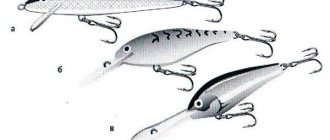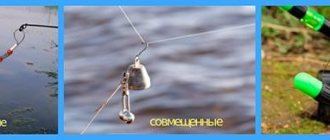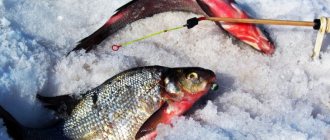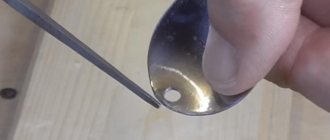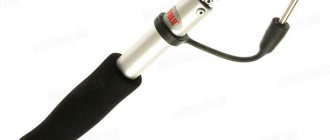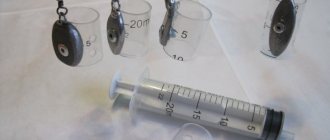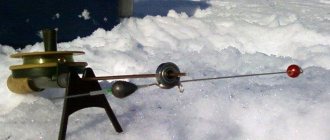What is a spider fishing tackle?
A fishing spider, or also a product called a lift in the fishing community, is a fishing tool consisting of a square piece of mesh stretched between rigid metal rods of a frame, the upper part of which is connected to a specially designed device for this purpose, called a cross.
The gear is installed on the bottom at a point in the reservoir chosen by the fisherman and raised by means of a pole after a certain time interval, which is also arbitrary and depends only on the decision of the fisherman. The lift is convenient to use from bridges, or other building structures and objects of natural origin overhanging the water and convenient for the angler’s location.
In this case, the net is lifted without a pole, using only a rope. When the device is lifted from the water, the fish swimming above the mesh sheet falls into a slug of gear formed from the water pressure and is taken to the shore. With this method of fishing, the caught fish has absolutely no damage, and can remain viable for a long time, kept in water under optimal temperature conditions.
Gear device
A fishing spider, or, as it is also called, a lift, is a square mesh stretched using a metal frame. It consists of the following elements:
- Cross. This is the top and base of the spider. It consists of two hollow tubes welded perpendicularly, to which a rope loop is attached on top.
- Four rods. These elements hold the entire structure in working position. Their lower ends are attached to the corners of the canvas, and the upper ends are inserted into the cross tubes.
- Net. Depending on the purpose of the tackle, it can have very different side lengths and cell sizes. It is secured using a sliding method on a square rope base stretched between the edges of the rods. This connection method allows the tackle to bend better under the resistance of the water at the right moment, creating a pocket for the fish being lifted.
- Rope. It should have a length depending on the casting location, a small thickness to minimize resistance, but at the same time be very tensile strength, since when rising it will need to take on the resistance of not only the fish, but also the water.
- Pole. Its length also directly depends on the fishing conditions. When choosing a pole, it is important to combine high strength with relative lightness, since you will have to hold it for quite a long time, and the large weight will cause inconvenience, including when lifting.
This is interesting: How to process roe deer horns at home
Despite the apparent external complexity, the lift is very simple. Even a child can understand its design and operation.
Types of fishing lifts
In semi-flowing reservoirs with strong currents, a spider with a rigid base is used. A net with increased sagging is placed on a round or square frame, which allows it not to be overloaded when lifting. The device rests on the bottom with one edge.
Ponds with active currents also use a spider fishing tackle known as a parachute. The configuration of the lift resembles a net, has a large net slack, and is equipped with a frame made of reinforcement or metal rods. A thick rope is fixed to the base, consisting of four slings of different lengths, the angle of inclination of the structure is 45°.
Among homemade models, the cradle is popular. It is assembled from metal (galvanized) mesh measuring 500/500 or 1500/1500 mm. The cross section of the cells is 5−20 mm. The net is slightly bent, attached to the four corners of the rods, tied together, and fixed on ropes. Fishing with a spider cradle is done by regular casting or pulling it out of the water at an angle of 45°.
How to fish
Catching fish with this gear is technically very simple, but requires a certain amount of physical training from the fisherman. To do this, you need to choose a place with no or moderate current, assemble the lift and, using a pole, throw it into the water so that it lies in a net on the bottom. Next, fishing is carried out blindly: the structure rises with a sharp movement, capturing all the fish located above it at that moment. It is important to do this quickly enough so that the prey does not have time to swim out of the net while moving.
This is interesting: How to distinguish a toadstool from an edible mushroom: signs of poisonous mushrooms
In addition, when using a spider, there are seasonal characteristics. When fishing in spring, for example, especially at the beginning, this fishing tackle gives a head start to most others. During the period of rising water levels, when a significant part of the fish practically does not react to bait, the spider can save the fisherman from an empty cage. Spring fishing is usually done from the shore, as fish, especially small ones, begin to move out of the holes into areas with warmer water. During this period, you can also use bait to attract prey.
In summer, fishing for spiders is made easier by the fact that after the turbidity settles, there is already a chance to see fish in the water column. However, during this period, prey tries to stay at depth, which is why it is best to choose small river beds for fishing or fish in deep places from bridges, piers and other similar structures hanging over the water.
In autumn, the activity of fish increases, it begins to move around the reservoir, which is why the fisherman needs to lift the tackle more often. At the same time, you can fish quite successfully almost anywhere.
For winter fishing, you can use both a special and a classic spider. In the first case, the tackle is lowered into the hole, which allows you to change the fishing location quite often in search of a more successful option. When fishing with a conventional lift, it is necessary to cut an ice hole, which is why it will not be possible to effectively explore the reservoir with it, especially if the ice is already about a meter thick. It needs to be raised less frequently in winter due to low fish activity.
Common for summer fishing
A fishing spider in the classic design is a little spider. It is with its help that fishermen catch the lion's share of live bait in the summer. The design of the tackle is quite simple and consists of a square mesh, a blind cross and four rods. On the crosspiece in its upper part there is a fastening ring for winding the lifting rope.
A wooden or aluminum pole for this small spider for catching live bait, as a rule, does not exceed four meters, and a seven-meter piece of rope or cord 6–8 mm thick is sufficient for most conditions for conducting the preparatory part of the main live bait fishing. Some models of the dwarf are equipped with side wing-aprons that rise 5–10 cm up along the perimeter of the mesh fabric. Their purpose is to serve to keep small fish in the mesh fabric, from rolling outside its boundaries at the moment when the tackle rises from the water.
Types of spiders
The spider tackle, having a general principle of its operation, differs only in the size, shape and design of the cross. Otherwise, the composition of the tackle remains unchanged, consisting of a mesh fabric, a rod frame and a cross-lock. In appearance, a fishing lifting net can be a classic tetrahedral shape, a modernized hexagonal variation and separated into a separate direction and type of tackle - spider-shell. The shells are small in size and can be round in shape, in the form of four or six sides. Fishing for spiders can be carried out at different times of the year, and for these purposes, fishermen have developed structures that can sink under the ice. In continuation of the article, we will dwell in more detail on the most popular models of the device.
Important! But I would definitely like to note that the legal fishing tool is a spider with a web size of 100x100 cm and a cell size of 1x1 cm, called by fishermen a little spider.
Fishing tactics
To successfully fish for any spider, you need to know the topography of the pond. Experienced fishermen choose places:
- with a slight slope;
- next to a snag or log;
- near water thickets;
- under bridges or near the bottom of a pit.
After choosing a place for fishing, the spider is thrown into the water and periodically checked for catch. This method of fishing is suitable for daytime and nighttime. To simplify the procedure for pulling out a massive structure, another rope is attached to the pole.
We suggest you read: What to do if you are bitten by a karakurt or another spider, what bites look like (photos) and how they are dangerous, consequences, first aid
Large spiders
Fishing with spiders in excess of the size standards specified in the previous sections of the article in the vast majority of regions of our country is poaching. But large lifts are used in industrial fishing by fishing teams and even vessels specialized for such a device. Of course, due to their large mass, such spiders cannot be lifted by hand and electric winches with metal cables are used for this. For fishing, the poacher uses an elongated and durable pole, but made of lightweight materials, and a reliable synthetic rope.
Making your own spider
Do-it-yourself fishing spiders are made from various materials in several ways. The simplest solution is to connect a pair of metal rods and a ring for fastening the rope by welding.
Then the edges of the rods are bent so that the mesh fits on them with a slight sag. The dimensions of the device and cells are selected depending on the expected catch. A factory-made small spider for catching live bait can also be bought in fishing stores.
A fishing rod in the shape of a fishing spider can have a collapsible design. To make it you need a cross and metal rods. The length of the elements is selected taking into account the desired dimensions of the elevator being designed. If the length of each side is more than one meter, the tackle is legally classified as poaching tools. In the finished product, the racks can be removed from the crosspiece or disassembled themselves, increasing compactness.
The idea is implemented in two ways:
- using a threaded connection. It is practical and effective, but has one drawback - the complexity of the disassembly and assembly process of the gear. But in terms of reliability, it ranks first among analogues;
- option using pieces of pipe. In such a device, the rod is placed in place without gaps. A similar fastening method is used in plug rods. Half of the tube is welded to the foot of the tackle, the second part remains open and is easy to clean.
The speed and convenience of disassembling the lift play an important role. It is easier to transport, use and store. It is not necessary to use metal parts during the manufacturing process. For a small network, a structure made of flexible wood is quite suitable.
Big spiders
Fishermen in some remote and remote places use huge lifts. It’s not easy to pull out such devices even empty. To solve the problem, mechanical advanced devices are used that facilitate the fishing process and strengthen the spider’s frame.
In small lifts you can use aluminum, in serious modifications - only iron. Instead of rope, a steel cable is often used. A special roller is mounted on the edge of the pole of dimensional spiders, and the tackle is lifted using a winch. The characteristics of such structures guarantee the capture of valuable large fish. Poachers use this method even during spawning. This is illegal and punishable by fines or imprisonment.
Manufacturing
Making a spider for fishing with your own hands is not very easy, but if you have certain skills, it is quite possible. To do this you will need:
- Net. You can weave a fabric of the required size yourself, however, if you do not have such skills, it is definitely better to buy it. Along the edges it should be placed on a thick fishing line.
- A durable metal tube with an internal diameter of about 7-10 millimeters and a length of about 60 centimeters.
- Four metal rods that fit tightly into the tube.
- Metal ring with a diameter of 2-3 centimeters.
- A piece of rope 4-9 meters long.
- Durable pole.
How to make a fishing spider with your own hands
A fishing spider is a fairly elementary piece of equipment in its structure and composition of elements, and it can be made at home, with your own hands, without much difficulty. The basis of the equipment is the net; all other parts of the equipment can be adapted from available means, which makes it possible to assemble a spider even in the field.
For the base of the lift, a network woven from synthetic threads, which are least susceptible to rotting, is suitable. You can use vine or willow twigs as arches, and equip the crosspiece with a strong joint knitting of four frame elements. Self-production of even such a primitive spider for fishing can allow you to catch a certain amount of fish in an extreme situation.
We suggest you read: Poodle's eyes are running
Before starting the manufacture of the lift, you need to decide on the dimensions of the final product in order to correctly select the mesh fabric required in terms of area, and also purchase a sufficient amount of metal rod for the arcs of the device. As we have already mentioned, it is best to purchase a mesh made of nylon fishing line for lifts, which is a fairly durable synthetic material that does not require special care after using it in a damp environment.
The fisherman will also need tubes for making a cross, the diameter of which should be comparable to the diameter of the metal rod that fits tightly into the hole of the pipe blank. Under the pole, wooden stakes or duralumin pipes up to six meters long and not exceeding 40 mm in thickness are used. To ensure the spider rises from the water, you will need about 10 meters of nylon cord no thicker than 8 mm.
Of the tools, the most complex equipment will be the welding machine, which will be needed to assemble the cross. In addition to welding equipment, you should have a small cutting machine or a hacksaw for metal, as well as pliers and a hammer for arranging hooks on metal rods for fastening the net. A sharp knife would be useful for working with nylon twine and tension threads.
Having decided on the size of the future lift, cut out the mesh fabric of the required perimeter and stretch a tension thread along its edges, which is tightly attached to the corners of the mesh, leaving loops. The next step is to prepare the crosspiece by welding its frame from tubes pre-cut to size. In the upper part of the cross, exactly in the center of the product, a fastening ring for winding the rope is mounted. Hooks are placed on four cut rods and loops made from thread drawn into the fabric are attached to them.
Next, the rods are tried on the crosspiece in such a way that when installing the rod into the hole of the tube on the canvas, a small sack is obtained, otherwise there is a sag of the mesh visible to the eye. The rods are cut to the required size and inserted into the crosspiece, completing the main assembly of the lift with your own hands with this operation.
Best places to catch spiders
The design of the fishing gear for the peculiarities of winter fishing during the freeze-up period should allow the rods to fold freely when lowering and pulling the spider from the drilled hole. If the mesh fabric and rods of the winter version of the tackle are identical in appearance to the summer version, then the cross has a number of differences, which, first of all, lie in the spring mechanism that works to transform the product.
The stiffness of the spring is adjusted in such a way that it makes it possible to fold the rods and allow the angler to push the tackle through the hole, where, once in the water, it will open into working condition. When making a lift, resting the cross against the ice, the springs of the mechanism will work in the opposite direction and make it possible to lift into the hole a net folded into a bag with fish caught in it. To make it easier to feed the frame of this tackle, fishermen use ice drills of the largest diameters.
We invite you to familiarize yourself with: Cinnamon and the Faun Cinnamon
Spider fishing requires the angler to know places with clean bottoms that are free of snags, aquatic vegetation and construction debris that can get caught on the installed net. Reservoirs with a strong current, which can carry away a net with their flow, are not always convenient for fishing with a lift.
Fishing is promising at the bottom of the pit, where the fish likes to hide during dangers, or after having fed during daylight hours, take refuge for the night. They always catch fish in water areas near bridges and directly under the structures themselves, where fish find secluded corners in parts of the reservoir shaded by the structure.
Having decided on a suitable place on the pond, spider fishing begins with installing the gear. They try to silently lower the fishing device to the surface of the water at a promising point and let it sink deeper, settling on the bottom. The pole rope, attached to the handle, remains in the hands of the fisherman. After installing the spider, they wait for a certain period of time, which is initially set arbitrarily, finding out the density of fish in the fished area of the reservoir. After waiting time, they smoothly lift the net and, if there are fish, pull the device ashore, collecting the catch.
Also, success can be brought by feeding the net installation area, when after casting, a portion of bait is fed into the lift, thus attracting live bait to the fishing site. Another effective method of fishing is to install a metal plate in the net that is different in color from the bottom, which attracts fish and also serves as a weight that allows you to install the net faster and improves its stability when fishing in currents.
A few tips for fishing in winter.
- A rope is tied to the tackle, which is used to pull out the prey. The second edge is attached to a pier or other stable object. Additionally, a wooden pole is mounted for additional fixation of the rope.
- Wear gloves to protect against cold and injury while retrieving the catch.
- The use of a spider when fishing from the shore involves attaching another pole, which plays the role of a landing net, facilitating convenient casting and pulling of the lift.
- It is better to fish in familiar and well-known areas. The presence of circular currents increases the chances of good catch.
- Night fishing is sometimes more productive than day fishing.
Features of fishing with a spider
There are other ways to collect a “spider” for fishing; among the fishing methods, “iron fishing” stands out well. The whole problem with the gear is that fishing on rivers with a “spider” is done blindly; the fisherman pulls the gear without knowing whether there is any catch. Even at shallow depths, the water is often so murky that visibility is practically zero.
Read more
Which fishing line to choose for a float rod?
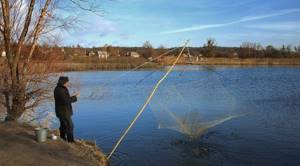
It is worth using bait if you plan to catch more small fish
The essence of using iron is to install a painted metal sheet, mostly white, on the bottom. The lift is installed directly on the iron sheet. As a large fish approaches, its silhouette will begin to contrast with the white color, and the fisherman will be able to hook in time.
If you plan to catch more small fish, you should use bait. Having thrown the bait mixture, wait a little while for medium-sized crucian carp and roach to swim to the spot, and then sharply remove the trap from the water.

